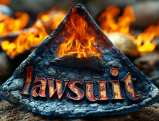
Explore the common traits of the best injury lawyers in California, including their specialized focus, experience, diligent case investigation skills, meticulous case valuation capabilities, and courtroom mastery. Gain insight into what distinguishes premier counsel in personal injury law, empowering optimal case resolutions despite challenges.
by LawInc Staff
January 4, 2024
Suffering an injury or illness due to another’s negligence inflicts physical, emotional and financial pain. Pursuing just compensation means navigating complex legal claims amidst trauma. Top attorneys across California share key competencies empowering optimal case resolutions despite challenges.
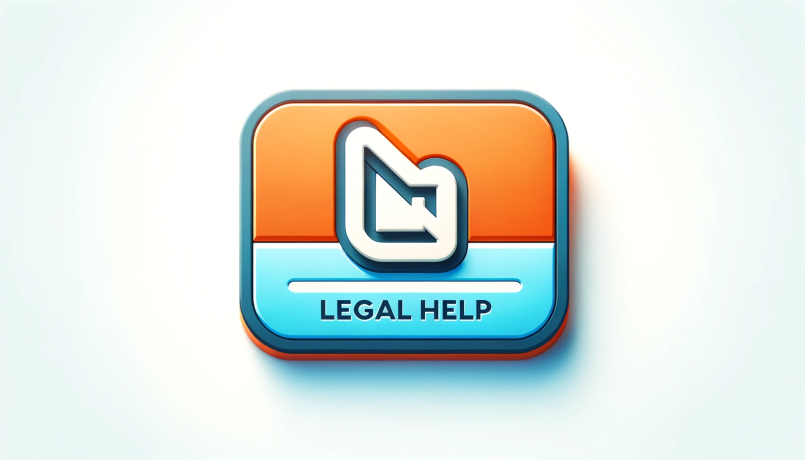
Need assistance with a California personal injury case or any other legal issue? Get in touch with us for expert help!
This guide covers core attributes unifying the state’s highest-caliber personal injury and disability lawyers. We detail litigation skillsets, client care tenets, negotiation approaches and more distinguishing premier counsel best positioned to deliver justice.
1. Specialized Focus and Experience
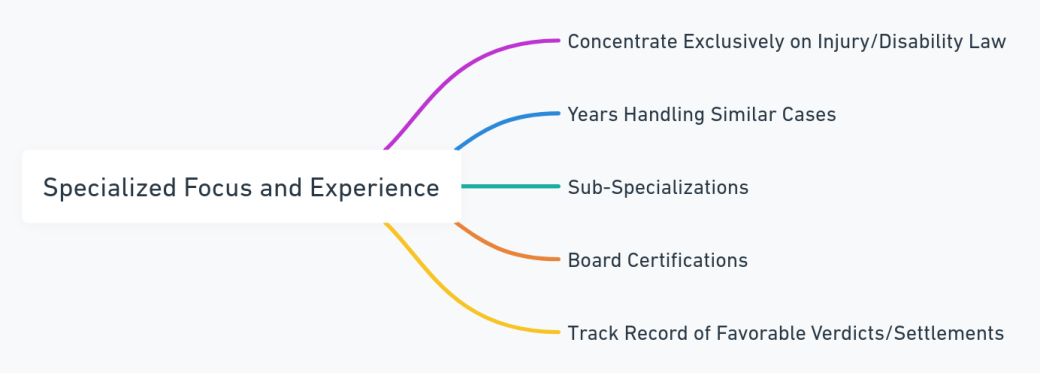
Exploring the Core Elements of Specialization in Injury and Disability Law
-
- Concentrate Exclusively on Injury/Disability Law: Avoid general practitioners lacking depth in niche claims expertise.
- Years Handling Similar Cases: Ask prospective lawyers their tenure specifically litigating matters akin to yours.
- Sub-Specializations: Some attorneys drill down further only taking medical malpractice, car crashes etc.
- Board Certifications: Legal specialization recognition indicates extensive qualification vetting.
- Track Record of Favorable Verdicts/Settlements: Review case results demonstrating competency.
Examples:
-
- Amanda practiced injury litigation full-time for over 20 years with deep expertise negotiating settlements.
- Dale handled numerous suits specifically tied to severe automobile collisions.
- As a certified specialist, Jack focused narrowly on medical malpractice disputes.
- Maria had a proven history of securing 7-figure rewards for clients injured by negligence.
- Steven’s record contained dozens of multi-million dollar verdicts across a spectrum of personal harm cases.
How to Proceed:
-
- Ask prospective attorneys exactly what percentage of their current caseload focuses on situations paralleling yours.
- Probe about length and variety in specific injury/disability cases argued not just general experience.
- Have them quantify litigation success rates and multi-million dollar precedent results.
- Validate specialty credentials checking state bar registration portals for official recognition status.
- Take them through nuances in your matter gauging familiarity with subtleties impacting strategy.
FAQs:
-
- What caseload size is ideal? 50-100 enables focusing without spreading too thin.
- How many years handling my specific injury type suffices? 10+ years builds best judgment many cases expose.
- What settlement rates indicate competency? Exceeding case-type averages suggests great skill – benchmark judiciously.
- Where are legal specializations verified? Check state bar association websites for attorney recognition designations.
- Can lawyers self-proclaim niche expertise without accreditations? Yes, so corroborate through data – don’t assume advertised focus.
2. Diligent Case Investigation Talent
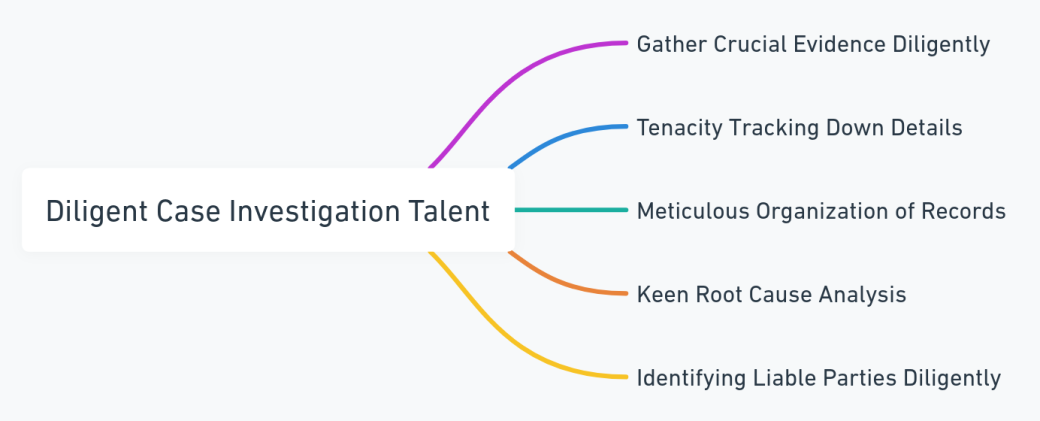
Key Skills in Diligent Case Investigation for Attorneys
-
- Gather Crucial Evidence Diligently: Photos, police reports, medical charts etc. comprise case foundations.
- Tenacity Tracking Down Details: Finding obscured facts – witness accounts, product defects etc. – builds leverage.
- Meticulous Organization of Records: Precise chronological documentation sequencing empowers strategy.
- Keen Root Cause Analysis: Differential diagnosis talent strengthens causality arguments.
- Identifying Liable Parties Diligently: Thorough vetting – manufacturers, contractors etc – makes or breaks cases.
Examples:
-
- Robert left no stone unturned gathering police dash cam footage from the truck accident.
- Michelle doggedly tracked down operating room nurses present to probe undocumented errors.
- Meticulous timelines aided Gary demonstrating precisely how medication side effects escalated severity.
- Paula’s differential analysis strengthened cancer causal links to chemical plant emissions.
- Carl traced defective airbag explosions to manufacturer design flaws through rigorous investigation.
How to Proceed:
-
- Ask how thoroughly attorneys dig beyond obvious evidence sources like medical charts, police reports etc.
- Query about processes ensuring meticulous organization of gathered records to best understand case histories.
- Discuss how they determine whether lawsuits warrant naming singular or multiple defendants.
- Review examples of evidence chronologies they’ve compiled to showcase thorough sequencing.
- Have them walk through diagnostic sequences assessing root injury attributions.
FAQs:
-
- Is gathering my own documentation sufficient? No, lawyers’ investigation skills probing deeper prove pivotal most cases.
- How far back should they search history to establish sufficient causal links? Years before injuries manifested tracing incremental contributing factors.
- Can circumstantial evidence carry much weight if concrete records unavailable? Less ideally yet still useful providing factual corroboration when aptly positioned.
- What resources can identify previously linked product defects? Freedom of Information Act requests, Consumer Product Safety Commission databases etc
3. Meticulous Case Valuation Capabilities
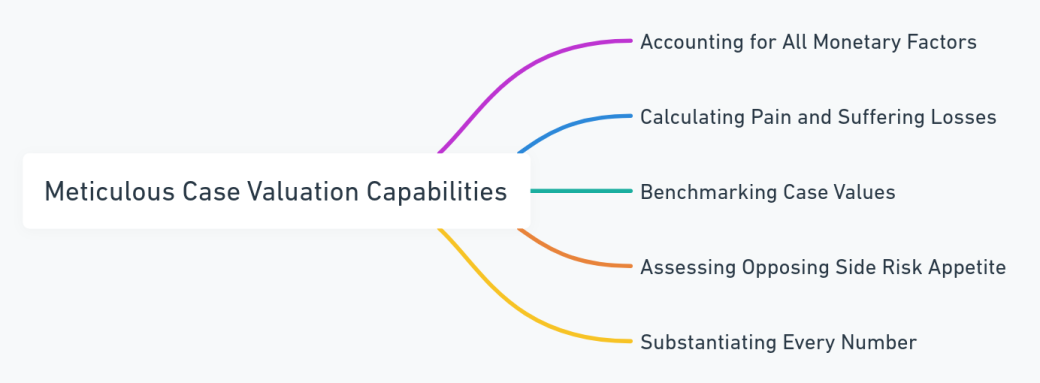
Exploring the Intricacies of Case Valuation in Legal Cases
-
- Accounting for All Monetary Factors: Medical bills both current and projected, lost wages etc.
- Calculating Pain and Suffering Losses: Quantifying physical/mental distress and impact on quality of life.
- Benchmarking Case Values: Comparing severity and outcomes across similar precedents.
- Assessing Opposing Side Risk Appetite: Determining liability scale and PR sensitivity.
- Substantiating Every Number: Granular documentation justifies compensation scale.
Examples:
-
- Jamaal’s counsel precisely calculated and proved over $3M in present/future medical costs.
- Rhonda’s attorney commissioned economic research supporting her $480k lifetime lost wages.
- In Angela’s case, the hospital’s risk management team’s history showed appetite to settle major negligence cases quickly to contain public scrutiny.
- Meticulous documentation accompanied Joyce’s $22M demand substantiating extraordinary suffering warranting substantial redress.
- Paul’s counsel benchmarked against 20 precedent rulings in analogous motorcycle defect suits when calculating.
How to Proceed:
-
- Verify case valuation competency requesting examples of recent monetary demand substantiation.
- Ask lawyers to walk through how they calculate lifetime care costs for permanently disabling injuries.
- Discuss precedents with analogous factors they use to benchmark potential award scopes.
- Have them share instances where settlement offers reflected defendants’ appetite for risk avoidance.
- Inquire about pain and suffering scale quantification based on case circumstances.
FAQs:
-
- What software tools best calculate lifetime care costs? Programs like Settlement Planner and MC Calculations aid reliable projections.
- Do lawyers need financial expert testimony bolstering monetary demand estimates? Helps substantially – gives calculated figures third-party credibility carrying weight.
- Can juries award sums exceeding what legal teams request? Yes absolutely in extraordinary circumstance cases juries deem egregious.
- What degree detail substantiating suffering losses suffices? Very granular documentation correlates to award scopes juries and judges allow.
- Is emotional distress redress considered hard dollar “damages”? No, classified as non-economic yet quantifying similarly crucial.
4. Courtroom Mastery with Verdict-Winning Instincts
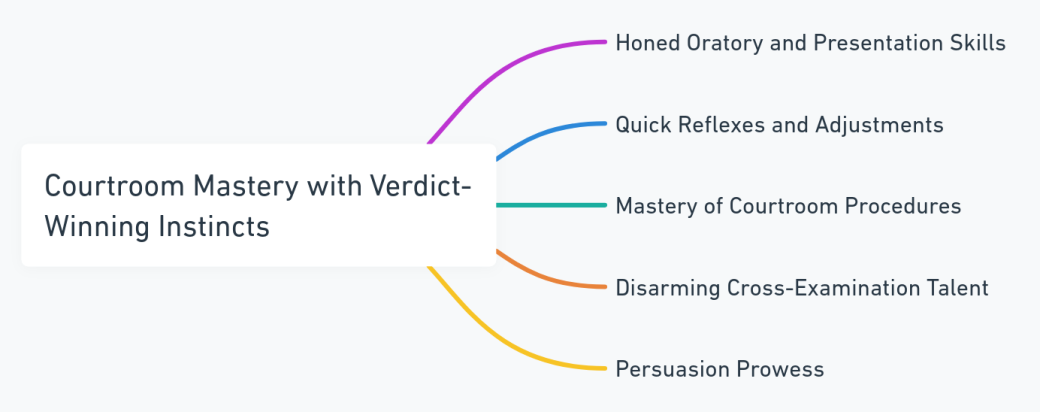
Key Competencies for Achieving Courtroom Mastery and Winning Verdicts
-
- Honed Oratory and Presentation Skills: Swaying juries requires aligning arguments persuasively to facts and exhibiting grace under pressure.
- Quick Reflexes and Adjustments: Top litigators reshape approaches adapting to judges’ reactions and opponents’ maneuvers.
- Mastery of Courtroom Procedures: Following rules of evidence and litigation protocols.
- Disarming Cross-Examination Talent: Leading questions extract favorable admissions whileobjections sidestep traps.
- Persuasion Prowess: Psychology, emotion and logic balance for greatest influence.
Examples:
-
- Andre’s unwavering eye contact cements believability.
- Lucia translates multifaceted medical issues into graspable concepts.
- Seemingly innocuous questions lead foes to Tim’s narrative traps.
- Grace swiftly refutes attempts at misdirection, muddying issues.
- Passionate pleas touching jurors’ humanity win days for Natalie’s clients.
How to Proceed:
-
- Observe prospective attorneys in action via video samples if possible.
- Discuss approaches humanizing clients, overcoming preconceptions.
- Ask about strategies handling expert witness cross-examinations.
- Enquire how they simplify convoluted arguments without losing substance.
- Choose counsel adept at credibility building, explanatory power and inspiration.
FAQs:
-
- How much does physical appearance influence perceived credibility? Somewhat initially but substance ultimately determines outcomes more.
- What distinguishes powerful speakers and writers? Clarity, relatability and infectious conviction.
- Should lawyers display some combativeness under tough cross-examination? Strategically channeled anger has a place when warranted contextually.
- Is courtroom mannerism teachable or innate? Combination of both – even naturally gifted orators perfect presence with dedicated practice.
- How important are closing statements relative to evidentiary arguments? May tip split decisions by hammering home key human impacts worth compensating.
5. Commitment to Client Wellbeing
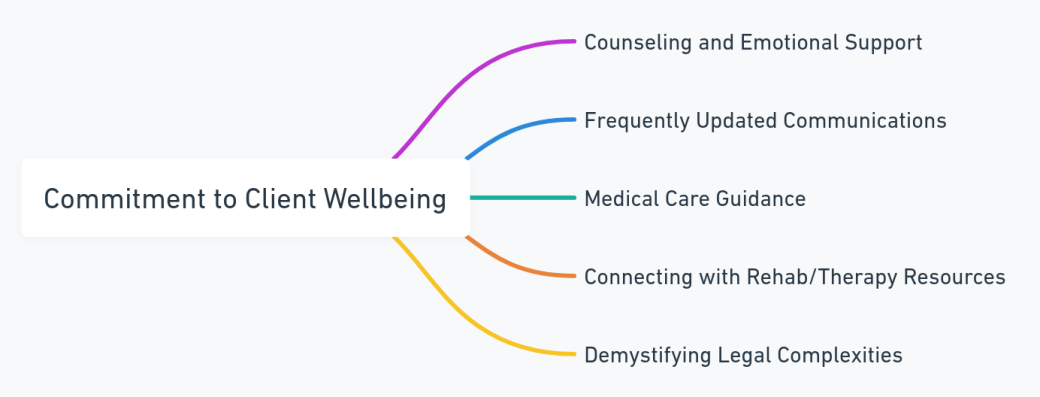
Understanding the Dimensions of Client Wellbeing in the Legal Field
-
- Counseling and Emotional Support: Leading attorneys offer validation and encouragement during challenging times.
- Frequently Updated Communications: Premiers counsels continually inform clients of case progress across all stages.
- Medical Care Guidance: Top lawyers provide advice navigating treatment options and securing optimal care.
- Connecting with Rehab/Therapy Resources: Ideal advocates assist accessing restorative health services and financial aid facilitating.
- Demystifying Legal Complexities: Leading attorneys translate convoluted processes into understandable terms.
Examples:
-
- Howard offered compassion along with strategic guidance by Marissa’s side through her ordeal’s ups and downs.
- Detailed briefings every two weeks kept Carlos closely informed at each phase without information gaps.
- Natalie introduced premier specialists optimizing chronic care for Edgar’s lifelong disability.
- Connecting with nonprofit aid organizations helped fund physical rehabilitation Tammy’s recovery demanded.
- Ronald clearly translated intricate legal terminology so Kyle fully grasped proceedings impacting his case.
How to Proceed:
-
- Ask attorneys about what counseling and shoulder-to-lean on support they offer navigating rollercoaster case journeys.
- Have them outline communication frequency and content they pledge to deliver keeping clients closely informed.
- Discuss any guidance offered connecting with renowned medical experts and securing financial assistance for restorative care.
- Verify simplicity and clarity of legal issue explanations they provide clients.
- Select counsel demonstrating both human compassion and skill disseminating complex case knowledge understandably.
FAQs:
-
- How much informational detail is excessive? Transparency critical but avoid overwhelming with tangents diluting key milestone updates.
- What medical guidance crosses ethical boundaries? Avoid specific treatment directives – general input laying out options may guide appropriately.
- Can attorneys offer mental health counseling themselves? Generally not advised – provide connections to vetted professionals.
- Should lawyers ever withhold case details if news proves unfavorable? No, authentic compassion means delivering bad news sensitively when needed.
- What separates client caregivers vs legal tacticians? Both skill sets integrate – stellar injury advocates blend supportive plus strategic capabilities.
6. Meticulous Trial Preparation
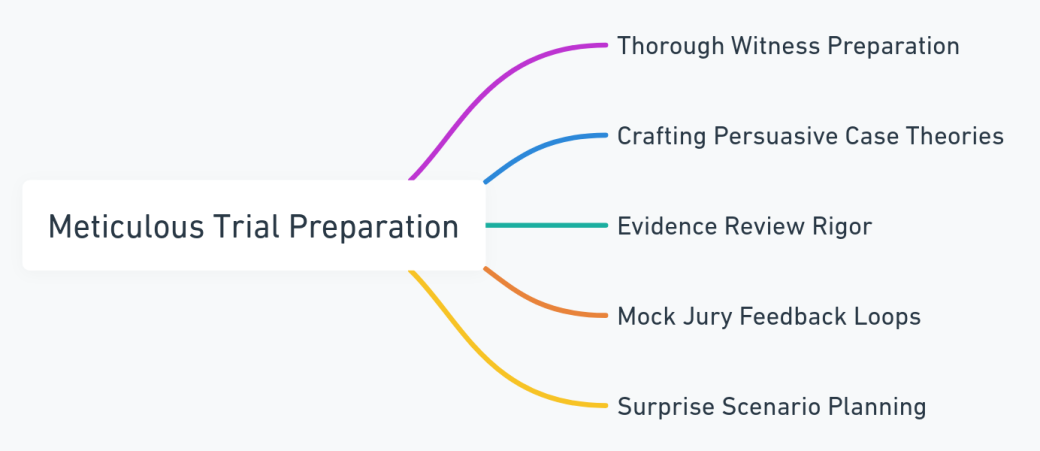
Essential Aspects of Preparing for Trials in Legal Practice
-
- Thorough Witness Preparation: Refining testimony delivery and anticipating cross-examination tactics.
- Crafting Persuasive Case Theories: Theme narrative synthesis weaving arguments cohesively.
- Evidence Review Rigor: Inspection ensuring exhibits pass admissibility tests.
- Mock Jury Feedback Loops: Fine tuning based on sample juror reactions.
- Surprise Scenario Planning: Alternate approaches preparing for unforeseen developments.
Examples:
-
- Extensive role-play sessions optimized composure and impactful narratives under pressure for Linda’s key witnesses.
- The cohesive storyline Thomas’ counsel crafted foreshadowed negligence conclusions jurors later embraced.
- Meticulous verification ensured all visual aids withstood evidentiary tests before Brooke’s trial.
- Pretrial focus group feedback exposed flawed assumptions Michael’s team remedied beforehand.
- Kevin’s lawyer devised alternative theories adapting as proceedings brought surprising revelations.
How to Proceed:
-
- Ask how thoroughly attorneys prepare key witnesses to deliver poised testimony.
- Request examples of previous compelling case themes demonstrating storytelling prowess.
- Discuss evidence review and trial exhibit verification procedures reducing surprises.
- Verify if juries are ever used to preview arguments identifying weaknesses.
- Ensure lawyers strategize responsive contingency plans anticipating unpredictable arise.
FAQs:
-
- What separates great trial attorneys from merely competent counterparts? Meticulous preparation and rehearsal supporting improvisational poise when pressed.
- How long should lawyers prepare witness trial testimony? Months of consistent memory refreshers and situational dry runs.
- Is trial preparation reasonably attorney do-it-yourself territory? Collaboration with wider expertise like jury consultants typically boosts prospects.
- Might trial graphs/visuals still have admissibility risks despite review? Yes, judges can rule certain exhibits prejudicial regardless – contingency options help.
- What’s better for plaintiffs – bench trials or jury trials? Typically juries especially when plaintiffs prove sympathetic.
7. Accessibility and Responsiveness
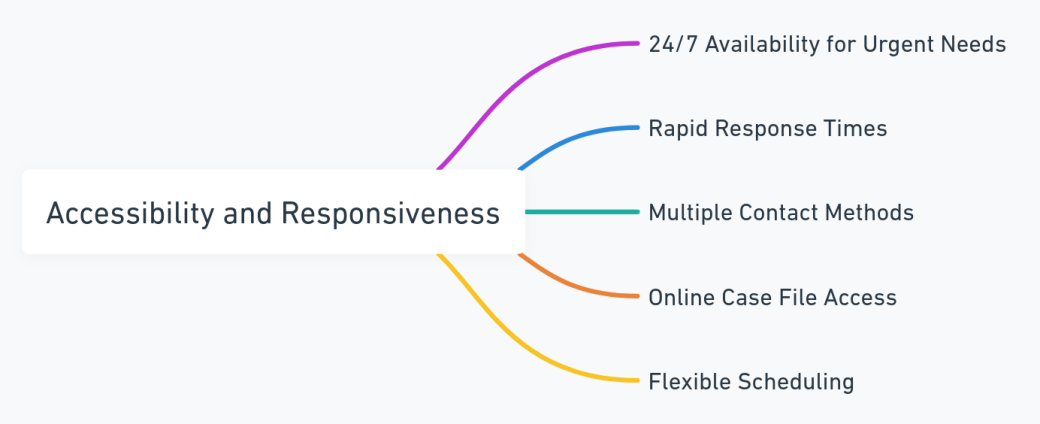
Key Factors in Ensuring Accessibility and Responsiveness for Legal Clients
-
- 24/7 Availability for Urgent Needs: Top attorneys provide round the clock contact channels for pressing legal issues.
- Rapid Response Times: Leading lawyers quickly return calls/emails, avoiding client uncertainty.
- Multiple Contact Methods: Premier counsel makes reaching them easily through phone, email, portal messaging etc.
- Online Case File Access: High performers grant document visibility via secured portals 24/7.
- Flexible Scheduling: Accommodating attorneys adapt timing conveniences fitting client needs.
Examples:
-
- Amanda’s law firm provided a round the clock hotline for urgent issues between official business hours.
- Isaac promptly returned emails within 30 minutes assuring clients of priority attention.
- Clients appreciated Eduardo’s messaging system, email, and cell phone call options reaching his staff.
- Secure online case portals gave Sandra 24/7 access to records related to her claim.
- Accommodating schedule changes for important family events distinguished David’s service.
How to Proceed:
-
- Verify 24-hour access availability for pressing offline legal counsel needs.
- Note response timeliness gauging responsiveness strengths.
- Inquire which mediums they pledge to continually monitor for reaching out.
- Ask about case document visibility policies via online portal platforms.
- Select attorneys focused on adapting timing suitabilities around important client events.
FAQs:
-
- What urgent needs warrant 24/7 legal access? Primarily unexpected incidents, arrests or time-sensitive filings.
- How rapid should communication response times be? Within the hour for phone calls, within 1 business day for other mediums generally suffices.
- Is client case portal access a security risk? Encrypted channels with authentication safeguard sensitive information.
- What flexibility is reasonable to expect for lawyers’ hectic schedules? Some workflow modifications can accommodate important personal events.
- How many contact mediums should attorneys offer? At minimum – phone, email and online messaging system.
8. Networking with Medical & Rehab Experts
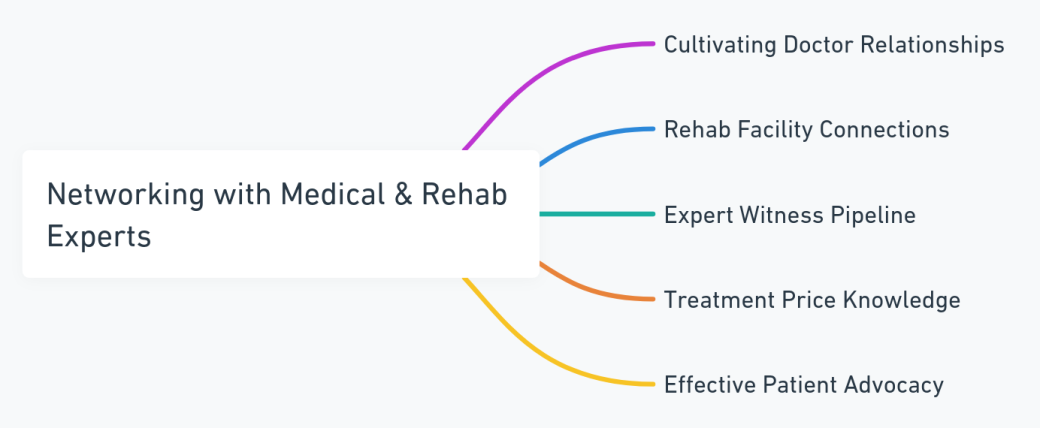
Exploring the Role of Medical and Rehab Expert Networks in Legal Cases
-
- Cultivating Doctor Relationships: Leaning on testimonials from top treating physicians carries weight.
- Rehab Facility Connections: Partnering with acclaimed recovery programs boosts continuity.
- Expert Witness Pipeline: Renowned specialists willing vouching for case validity.
- Treatment Price Knowledge: Vetted care provider cost familiarity aids financial planning.
- Effective Patient Advocacy: Guiding injury victims in optimizing medical care quality throughout recovery phases.
Examples:
-
- Leveraging longtime doctor relationships, Cynthia obtained persuasive support letters validating case merits.
- Thanks to Theo’s rehabilitation hospital partnerships, clients accessed award-winning trauma recovery programs.
- Arjun cultivated a diverse roster of medical experts fully willing to provide testimony when case developments dictated need.
- Veronica maintained price sheets from credentialed home health aides assisting clients anticipating future care costs.
- As an adept patient advocate, Alicia ensured clients secured optimal specialty surgeon consultations and treatment course corrections when required.
How to Proceed:
-
- Ask prospective lawyers about esteemed medical and rehab professions they interact with.
- Discuss if they facilitate introductions to top-tier care facilities.
- Inquire about technical healthcare insights they offer guiding patients.
- Verify qualifications of go-to medical experts tapped for opinions or testimony.
- Choose attorneys with fruitful care community connections willing assisting case advancement.
FAQs:
-
- Won’t doctor relationships introduce bias helping patient legal cases? Ethical practitioners avoid testimony conflicts yet insight sharing remains appropriate.
- What credentials best qualify medical experts providing statements? Board certifications indicating niche specialization carry greatest weight.
- How much influence can rehab testimonials wield? Substantially bolster plaintiff sympathy and claimed injury magnitudes if from prestigious institutions.
- Is it advisable introducing clients to new doctors absent history? Yes if change necessitated yet transitions should minimize information gaps.
- Can attorneys recommend specific treatment providers? Ethically problematic – general guidance only; patients choose physicians.
9. Mastery of Injury Negotiation Strategies
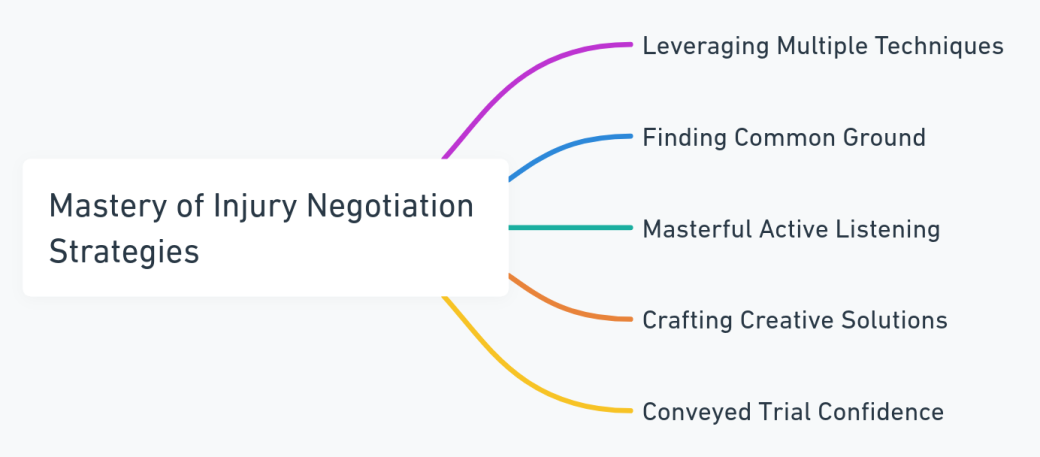
Essential Techniques for Effective Injury Negotiation in Legal Cases
-
- Leveraging Multiple Techniques: Top attorneys alternate adversarial and cooperative approaches strategically.
- Finding Common Ground: Aligning interests for mutually acceptable settlements.
- Masterful Active Listening: Identifying opponent priorities through their verbal and nonverbal cues.
- Crafting Creative Solutions: Proposing conditional stipulations bridging differences.
- Conveyed Trial Confidence: Believable willingness to litigate bolsters bargaining posture.
Examples:
-
- Andrea demonstrated her flexibility shifting between empathetic and hardline stances effectively per situation need.
- Finding mutual concern over negative publicity, Craig brokered an inflation-tied settlement package on his client’s behalf.
- Keen listening abilities allowed Sofia to spotlight adversary prioritizations guiding her subsequent positioning.
- Prasad proposed indexing offered amounts to life expectancy to bridge compensation gaps.
- Clear messaging around Roger’s willingness to litigate rather than acquiesce extracted greater concessions.
How to Proceed:
-
- Ask about the settlement rates they achieve relative to case type averages.
- Have them detail how they’ve creatively aligned interests to secure favorable outcomes.
- Discuss how adept they are at reading opponents’ body language during negotiations.
- Inquire about tactics getting reluctant parties to reveal case weaknesses.
- Select counsel able balancing adversarial leverage with cooperative give-take as conditions dictate.
FAQs:
-
- What negotiation style drives the best settlements? No universal best approach – context and flexibility determine what motivates counter-parties.
- Should attorneys demonstrate willingness to go trial? Credible litigation threat gives negotiating leverage so yes, within reason based on circumstances.
- What if opposition won’t budge – then what? Skilled counsel finds creative ways progressing. Surface hidden motivations. Align interests. Offer conditional concessions etc.
- Do injury settlement amounts correlate to attorney negotiation talent? Strongly so – their skillset plays pivotal role maximizing compensation from at-fault parties.
- How long should negotiations reasonably last before impasse declares? Months typically before stalemates become evident necessitating potential litigation.
10. Strong Reputation Among Peers
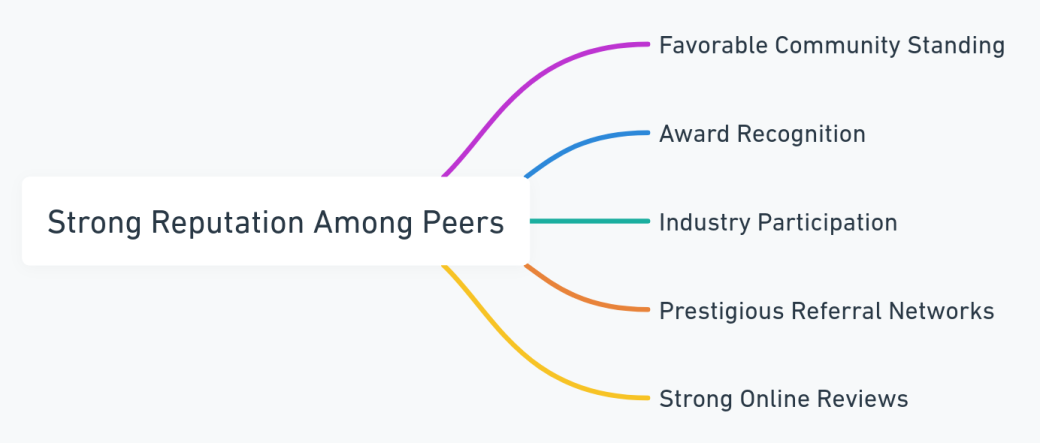
Factors Influencing a Lawyer’s Reputation in the Legal Community
-
- Favorable Community Standing: Well-respected locally among fellow attorneys and judges.
- Award Recognition: Earning accolades highlights excellence – Super Lawyers, Best Lawyers etc.
- Industry Participation: Leadership within professional associations indicates strong qualifications.
- Prestigious Referral Networks: Vetted attorney pools provide recommendations showcasing talent.
- Strong Online Reviews: Positive client feedback on experience working together.
Examples:
-
- Local judges and attorneys consistently highly praised Paula’s litigation excellence.
- As regional Best Lawyers designee for 6 straight years, Kris’ expertise stood undisputed.
- Chairing the city bar association personal injury section positioned Lorraine as go-to specialist.
- Membership in the Million Dollar Advocates Forum demonstrated Ben’s big case credibility.
- Online comments accentuated Gail’s attentiveness and results securing favorable verdicts.
How to Proceed:
-
- Seek input from judges, attorneys outside prospective counsel’s firms regarding reputations.
- Verify legitimate awardrecognition – some self-proclaimed industry accolades hold little weight.
- Ask about speaking engagements or leadership positions held within professional associations.
- Validate recommendations from credentialed referral networks.
- Check online ratings and comments regarding responsiveness and addressing needs.
FAQs:
-
- Which rankings carry greatest credibility? Super Lawyers, Best Lawyers, state bar recognitions.
- Can awards be purchased or manipulated? Some yes, so vet awarding organization and criteria closely.
- What referral networks best reflect attorney qualifications? State bar, American Association for Justice, elite law school alumni groups.
- Can negative online comments get removed? Very difficult without clear proof of falsehoods.
- How important is jury appeal relative to peer reputation? Among peers builds credentials; jury appeal sways given cases.
Summary

Did You Know? California’s ‘pure comparative negligence’ rule allows individuals to recover damages in personal injury cases even if they are 99% at fault, ensuring compensation is always within reach, no matter the degree of responsibility.
Pursuing just compensation through complex injury lawsuits proves extremely challenging, necessitating guidance from uniquely qualified legal professionals. The best attorneys in California boast certain core competencies – litigation prowess, unwavering work ethic, financial astuteness and relationship building talents.
Yet truly differentiating top counsel remains an unwavering client focus, coupled with compassionate support through legal processes and life rebuilding. By selecting representation aligned in priorities and values with your own, you equip yourself with the power to overcome current adversity.
Need an Injury Lawyer? Contact Us
If you or a loved one suffered harm due to negligence or wrongful actions, contact our law firm for a free consultation with an experienced California personal injury attorney. Skilled legal guidance protects your rights, wellbeing and financial recovery.
Evaluate Your CA Injury Attorney Selection Savvy
Questions: Specialized Focus and Experience
-
- 1. What background aids accident lawyers in maximizing case values?
- A) Medical expertise
- B) Negotiation experience
- C) Trial experience
- D) All of the above
- 2. How does focused specialization benefit injury lawyers?
- A) Attracts higher value cases
- B) Broadens regional scope
- C) Reduces niche competition
- D) Lowers caseload volume
- 3. What litigation knowledge is pivotal in accident suits?
- A) Healthcare regulations
- B) Product safety laws
- C) Vehicle insurance statutes
- D) All could apply
- 4. How may niche medical expertise assist in winning injury cases?
- A) Aids sympathetic client positioning
- B) Boosts legal issue comprehension
- C) Both of the above
- D) Neither of the above
- 5. What local knowledge shapes strategic legal arguments?
- A) Opposing counsel tendencies
- B) Past settlement rates
- C) Regional healthcare costs
- D) Common accident causes
- 1. What background aids accident lawyers in maximizing case values?
Answers: Specialized Focus and Experience
-
- 1. D) The combination of niche medical comprehension alongside negotiation mastery and courtroom skill proves most powerful maximizing injury case values.
- 2. C) Specialized focus reduces competing counsel with similar topical expertise, enabling prominence quickly attracting higher value cases.
- 3. D) Myriad regulations around vehicles, medical devices, workers compensation etc necessitate applicable command tailoring strategic arguments.
- 4. C) Both boosting sympathetic perceptions while comprehending technical issues allows niche medical knowledge to sway outcomes.
- 5. A) Understanding peculiarities of local players – judges, juries, attorneys – allows adapting approaches improving prospects.
Questions: Diligent Case Investigation Talent
-
- 1. What helps lawyers reconstruct accident sequences?
- A) Police report diagrams
- B) Ambulance GPS data
- C) Incident photographic evidence
- D) All of the above
- 2. Why interview reluctant witnesses in injury claims?
- A) Verify incident causes
- B) Assess injury magnitude
- C) Gauge plaintiff liability
- D) All of the above
- 3. What may subpoenaed records establish in injury claims?
- A) Safety procedure violations
- B) Prior complaint incidents
- C) Both of the above
- D) Neither of the above
- 4. Why research defendant backgrounds in injury claims?
- A) Assess credibility
- B) Gauge financial means
- C) Both of the above
- D) Neither of the above
- 5. How may meticulous evidence chronology aid injury plaintiffs?
- A) Proves cumulative impacts
- B) Establishes negligence
- C) Both of the above
- D) Neither of the above
- 1. What helps lawyers reconstruct accident sequences?
Answers: Diligent Case Investigation Talent
-
- 1. D) Photographic diagrams, vehicle telemetry records and medical response data help reconstruct sequences from multiple vantage points.
- 2. D) Interviewing unwilling observers aids verifying causes, judging injury scopes and determining comparative faults guiding strategy.
- 3. C) Subpoenaed safety audits, past infringement records etc help establish negligence degrees in injury disputes.
- 4. C) Vetting defendant credentials and financials enables calibrating legal arguments accounting for credibility issues and ability to pay.
- 5. C) Meticulous issue chronology marks incremental developments substantiating cumulative liability for resulting harms.
Questions: Meticulous Case Valuation Capabilities
-
- 1. What always warrants documentation in injury demand valuations?
- A) Property losses
- B) Ongoing medical costs
- C) Loss of household abilities
- D) Lost earning potential
- 2. What methodology balances precision with practicality for injury life-care cost projections?
- A) Plaintiff-specific health markers
- B) Regional healthcare CPI benchmarks
- C) Government actuarial data
- D) All of the above
- 3. What contextual clue aids assessing defendant inclination to settle injury cases?
- A) Industry publicity norms
- B) Case backlog statistics
- C) Prior incident patterns
- D) Leadership risk tolerance
- 4. What documentation style strengthens emotional distress claims in demands?
- A) Objective descriptions
- B) Detailed narratives
- C) Photographic support
- D) Healthcare provider corroboration
- 5. Why benchmark parallel injury case settlements?
- A) Substantiate amounts statistically
- B) Demonstrate severity relatively
- C) Highlight liability through comparison
- D) All of the above
- 1. What always warrants documentation in injury demand valuations?
Answers: Meticulous Case Valuation Capabilities
-
- 1. D) Documentation necessity extends across medical, household, property and income factors with precision needed qualifying claimed amounts.
- 2. D) Plaintiff health markers set care baseline needs while general and government data ensure projections remain grounded actuarially.
- 3. C) Defensive patterns around prior similar settlements offer clues into risk management approach influencing current negotiation stance.
- 4. B) First-person accounts substantiating emotional harms can profoundly impact settlement perceptions when positioned appropriately.
- 5. D) Benchmarking quantifies, contextualizes and attributes fault scopes against other analogous scenarios informing fair values.
Questions: Courtroom Mastery with Verdict-Winning Instincts
-
- 1. What visualization tactic may best simplify complex medical details for juries?
- A) MRIs
- B) Doctor testimony
- C) Illustrative models
- D) Patient photographs
- 2. Why maintain steady eye contact addressing juries in court?
- A) Build rapport
- B) Calibrate reactions
- C) Both of the above
- D) Neither of the above
- 3. What tactic targets witness credibility weakening during cross-examinations?
- A) Aggressive questioning
- B) Off-topic inquiries
- C) Pointed objections
- D) Visual aids
- 4. What closing statement approach typically proves most compelling for jurors?
- A) Cerebral analysis
- B) Emotional accounts
- C) Legal interpretations
- D) Mathematical calculations
- 5. How may trial experience aid settlement leverage pre-litigation?
- A) Boosts credibility
- B) Implies readiness
- C) Shows confidence
- D) All of the above
- 1. What visualization tactic may best simplify complex medical details for juries?
Answers: Courtroom Mastery with Verdict-Winning Instincts
-
- 1. C) Illustrative models distilling medical complexities through simple visualization best aid jury comprehension.
- 2. C) Unbroken eye contact builds connection while observing reactions provides real-time feedback tailoring arguments.
- 3. C) Pointed objections question premise credibility without appearing overtly combative before juries.
- 4. B) Stories tapping into moral conscience and relating human impacts typically prompt the most juror empathy.
- 5. D) Extensive first-chair trial experience boosts plaintiff attorney credibility, readiness and confidence – all settlement leverage factors.
Questions: Mastery of Injury Negotiation Strategies
-
- 1. What negotiation approach works best for uncooperative opponents?
- A) Empathetic
- B) Flexible
- C) Assertive
- D) Accommodating
- 2. What tactic reveals case weaknesses from settlement adversaries?
- A) Reflection questions
- B) Silent pauses
- C) Venting opportunities
- D) Future visioning
- 3. What expresses credible litigation readiness during negotiations?
- A) Anger
- B) vagueness
- C) Sympathy
- D) Confidence
- 4. Why customize negotiation style strategically?
- A) Adapt to personalities
- B) Align interests creatively
- C) Both of the above
- D) Neither of the above
- 5. What justifies prolonging negotiations before litigation?
- A) Achieving partial settlements
- B) Amassing tactical leverage
- C) Waiting on key evidence
- D) All of the above
- 1. What negotiation approach works best for uncooperative opponents?
Answers: Mastery of Injury Negotiation Strategies
-
- 1. C) More assertive posturing backed by credible litigation willingness brings stubborn parties to reason, whereas excessive flexibility signals weakness.
- 2. A) Thoughtful open-ended reflection questions allow adversaries to reveal doubts, priorities and case vulnerabilities to shape discussions.
- 3. D) Demonstrating graceful confidence backed by evidentiary command expresses readiness and power more than sympathy or aggression.
- 4. C) Adapting approaches to connect uniquely with different personalities and shifting creatively between cooperative/competitive as situations warrant proves most effective.
- 5. D) Partial agreements, building leverage and awaiting key documentation all justify sustaining talks if progress continues before commencing litigation.
Questions: Strong Reputation Among Peers
-
- 1. What industry recognition reflects elite injury lawyer performance?
- A) Graduating top law schools
- B) Million Dollar Advocates Forum
- C) Bar association roles
- D) Verdicts and settlements hall of fame
- 2. What community connection strengthens plaintiff credibility?
- A) Country club memberships
- B) Youth sports sponsorships
- C) Non-profit fundraising
- D) Local dining guide rankings
- 3. Which lawyer rating websites offer reliability?
- A) Niche
- B) Martindale Hubbell
- C) Super Lawyers
- D) All of the above
- 4. What industry recognition reflects litigation preparedness?
- A) Trial lawyer college fellow
- B) State bar certifications
- C) Both of the above
- D) Neither of the above
- 5. What peer recognition results from exceptional injury litigation leadership?
- A) University guest lecturing
- B) Industry book publishing
- C) Bar association presidency
- D) All of the above
- 1. What industry recognition reflects elite injury lawyer performance?
Answers: Strong Reputation Among Peers
-
- 1. B) Sustained 7-figure plaintiff verdicts and settlements merit formal induction into the Million Dollar Advocates Forum.
- 2. C) Visible community non-profit support builds positive public perception and familiarity reinforcing victim empathy.
- 3. D) All three rating websites enable extensive peer review substantiating top injury litigation performance.
- 4. C) Both elite specialty college completion and state bar association credentialing indicates courtroom preparedness.
- 5. D) Exceptional legal contributions prompt professional speaking invites, publishing deals and bar presidency roles.
Disclaimer
The information presented in this article on injury and disability lawyer selection is intended for general informational and guidance purposes only. The content does not constitute formal legal advice nor create an attorney-client relationship. While the authors strive to ensure accuracy of information, no claims or guarantees are made regarding potential results from use of contained information. Unique details of individual legal cases may necessitate different applications of the perspectives discussed. We advise directly contacting practicing attorneys for consultation specific to unique situations and in alignment with jurisdictional laws and regulations within relevant locations. State bar associations also provide referral services assisting with credentialed lawyer identification.
Also See
Los Angeles Personal Injury Lawyer Reveals Hidden Tricks Insurance Companies Don’t Want You to Know





